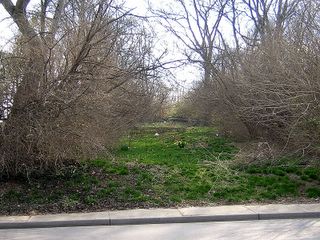As I wrote in Part III of this series, MetroCenter owns the only vacant residential properties in the upper “commercial zone” of North Salemtown. However, the side-by-side properties along MetroCenter Blvd. look more like the gateway to MetroCenter’s commercial developments farther north than a nascent residential block.
Half of the thin strip of land is landscaped with a steep, narrow grade and trees lining the crest: easy on the eyes of passing motorists on MetroCenter Blvd., but hard on houses if people were actually to live here. Moreover, if this were a gateway to an embryonic North Salemtown community rather than a commercial district, then quite logically, the industrial park-like “MetroCenter” sign would not be facing south at the tip of the northwest corner of Salemtown. The steep grade and the sign collectively encourage people to by-pass Salemtown altogether and to motor to the commercial offerings.
What, then, of MetroCenter’s holdings of vacant residential land in the lower “residential zone” of North Salemtown? I previously asserted that if zoning stays as is and MetroCenter holds a few vacant residential parcels in a predominantly residential block, then I have no worries about The Plan of Nashville’s call to do away with I-65.
However, the properties as they currently stand south of Clay seem to be lying fallow, overgrown, and unkempt. If we gauge MetroCenter’s commitment to the well-being of the Salemtown neighborhood based on the quality of development of their residential properties, we come up empty. The MetroCenter Blvd. gateway to their commercial holdings with its dark-wood mulched flowerbeds, strategically placed pine trees, and gleaming metallic sign seems to be dramatically more developed and inviting, despite its total lack of viable space for people to actually live.



No comments:
Post a Comment